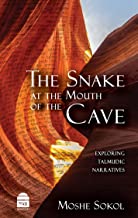By Rabbi Dr. Israel Drazin


BOCA RATON, Florida — While the Talmud and other rabbinic documents are known as volumes containing legal discussions, most people do not know that the Talmud and other rabbinic volumes such as Midrash also include non-legal writings about theology, ethics, psychology, health, and many other topics, as well as fascinating and delightful stories. Along with being appealing, riveting, and charming tales, these accounts also contain subtle often overlooked lessons.
Rabbi Dr. Moshe Sokol offers a very interesting easy to read study of eight dramatic reports about rabbis facing extreme difficulties. His analyses are exceptionally thoughtful. He asks questions about the narratives and offers wise insightful explanations. As much as we enjoy the stories before reading his examinations of them, we enjoy them much more when we read his penetrating thoughts.
The title of Sokol’s book, The Snake at the Mouth of the Cave, is the title of one of eight tales and is only one of several strange events in that tale. The stories focus on many human problems: improper behavior by pious men, interpersonal conflict, alienation, pain, triumph, success, failure, love, fear, anger, redemption, yearnings, and more. He analyzes all of the accounts in a rational eye-opening manner. He tells us the sources of each of them and gives us an enlightening introduction to each, including the biography of the main character and the conditions of the time he lived.
The first three are devoted to Rabbi Eliezer ben Hyrcanus. The leading scholar of his time, around 70 CE, said that Eliezer had a phenomenal memory; he was like a plastered cistern that never loses a drop. He absorbed and knew all the teachings of his predecessors. Eliezer is remembered for affirming, “I never said anything I had never heard from my teachers.” The first of the three tales is about his remarkable youth, how he only began to study at age 28.
The second, the most remarkable story in the book relates his disagreement with all other scholars, every one, and how several miraculous events occur proving he was right including God intervening in the dispute and declaring that he is correct about the issue at hand and is always correct. Yet, the ancient sages rejected Eliezer’s view, rejected the miracles that proved him to be right, and rejected God who declared that he was correct. And they went further. Despite his towering intellect and achievements, when Eliezer refused to accept their view they excommunicated him. How could they do this? How could they reject God? Is excommunication a proper reaction to a difference of opinion? Wouldn’t excommunication cause future students to be unable to learn from the wise Eliezer? Why does the story end with God being pleased with being rejected? The third tale tells about Eliezer dying, still refusing to accept the view of the majority.
The remaining five tales are also dramatic, raise questions, seem contrary to Jewish thought, yet Judaism accepts them as containing the truth.
The book’s fourth chapter analyses Akavya ben Mahalalel who refused to retract four of his legal decisions despite extreme pressure from the majority of rabbis, and who was also excommunicated. Why did the sages fear Akavya’s dissents? Isn’t this a violation of free speech? Why did Akavya dissent? What was so important that he was willing to be excommunicated rather than recant?
The fifth, sixth, and seventh stories looks at the behavior of the leading sage of Israel when Babylonia had more enlightened sages, Rabbi Yohanan ben Nappaha, traditionally recognized as the editor of the Jerusalem Talmud, who in the fifth chapter, refused to engage in business, and despite poverty, decided to spend time in study.
The sixth has his complex relationship with his close friend, brother-in-law, and student Reish Lakish, a former thief. The seventh describes how the relationship ended with both dying because Rabbi Yohanan refused to pray for Reish Lakish’s recovery, despite his sister’s heartfelt plea, when the tale reveals that his prayer would have saved Reish Lakish’s life, and Rabbi Yohanan realized his mistake and died in misery because of his despair.
And in the seventh, reverting to an earlier time, Rabbi Yohanan has a disastrous encounter with the sage Rabbi Kahana, seeks to resurrect him after killing him, and faces the snake.
The last chapter in the book is an analysis of the strange occurrence to Honi, the magic worker who could force God to bring rain, who slept for seventy years. Why seventy? Did it really happen? What did Honi learn? What do we learn? Honi was considered a very pious and knowledgable man. Why didn’t the people whom he met when he awakened try to learn from him?
How should we interpret rabbinic tales filled with miraculous and non-natural events? Should we accept them as literal reportage of actual events? Are the tales addressing the changes that occurred to Judaism after the destruction of the second temple in 70 CE and the ascendancy of Babylon over Israel? If so, what are they telling us? Is what they are telling us relevant today? What do the tales teach about relationships? What do the incidents tell us is a well-lived life?
Readers will find that Rabbi Sokol’s analyses address all of these questions and more. There is much in this 231 page book to entertain, teach, and improve us.
*
Rabbi Dr. Israel Drazin is a retired brigadier general in the U.S. Army chaplain corps and the author of more than 50 books.